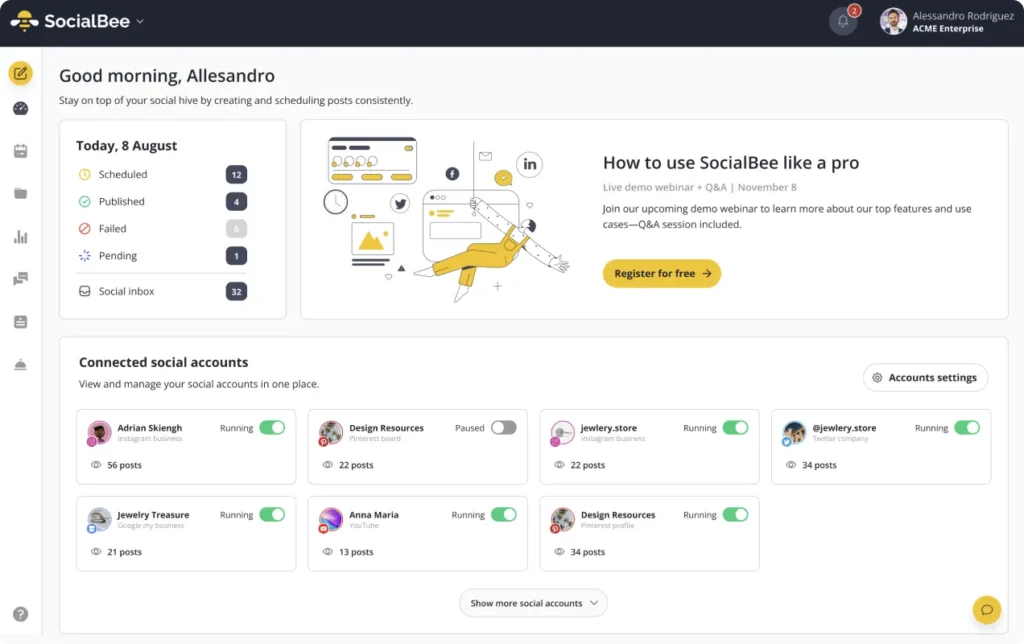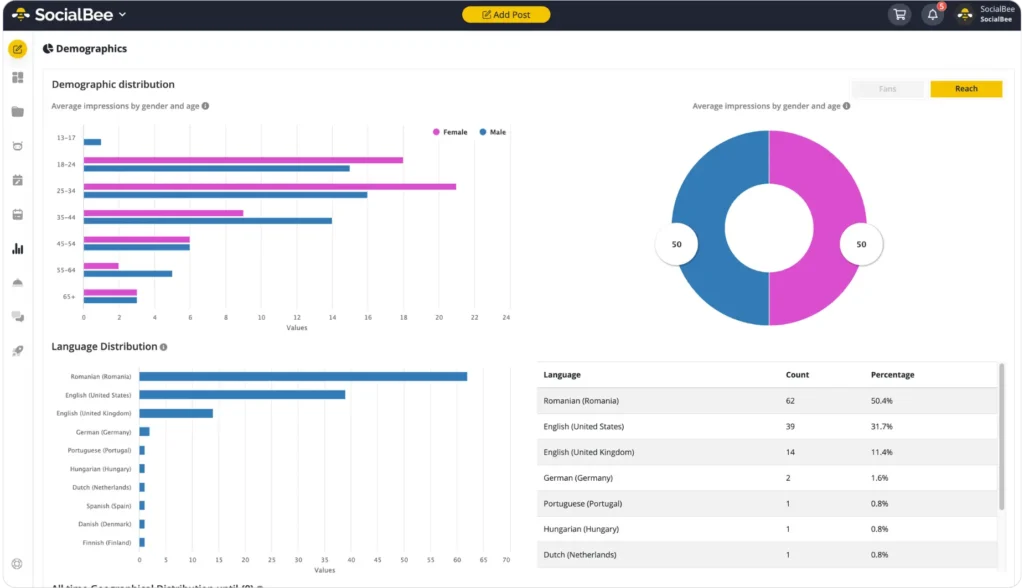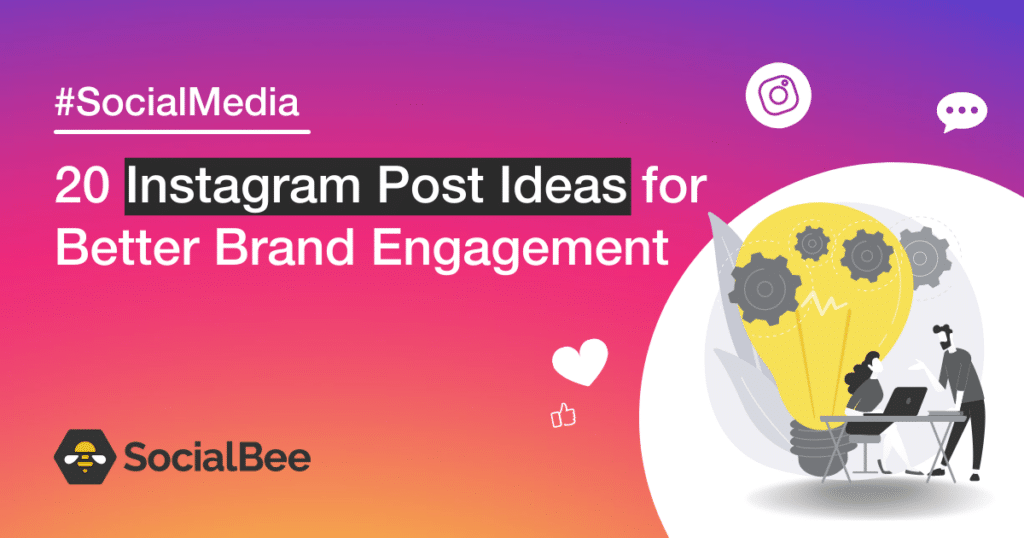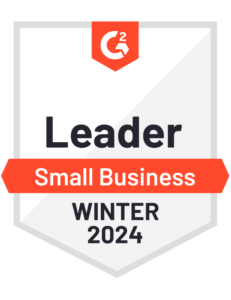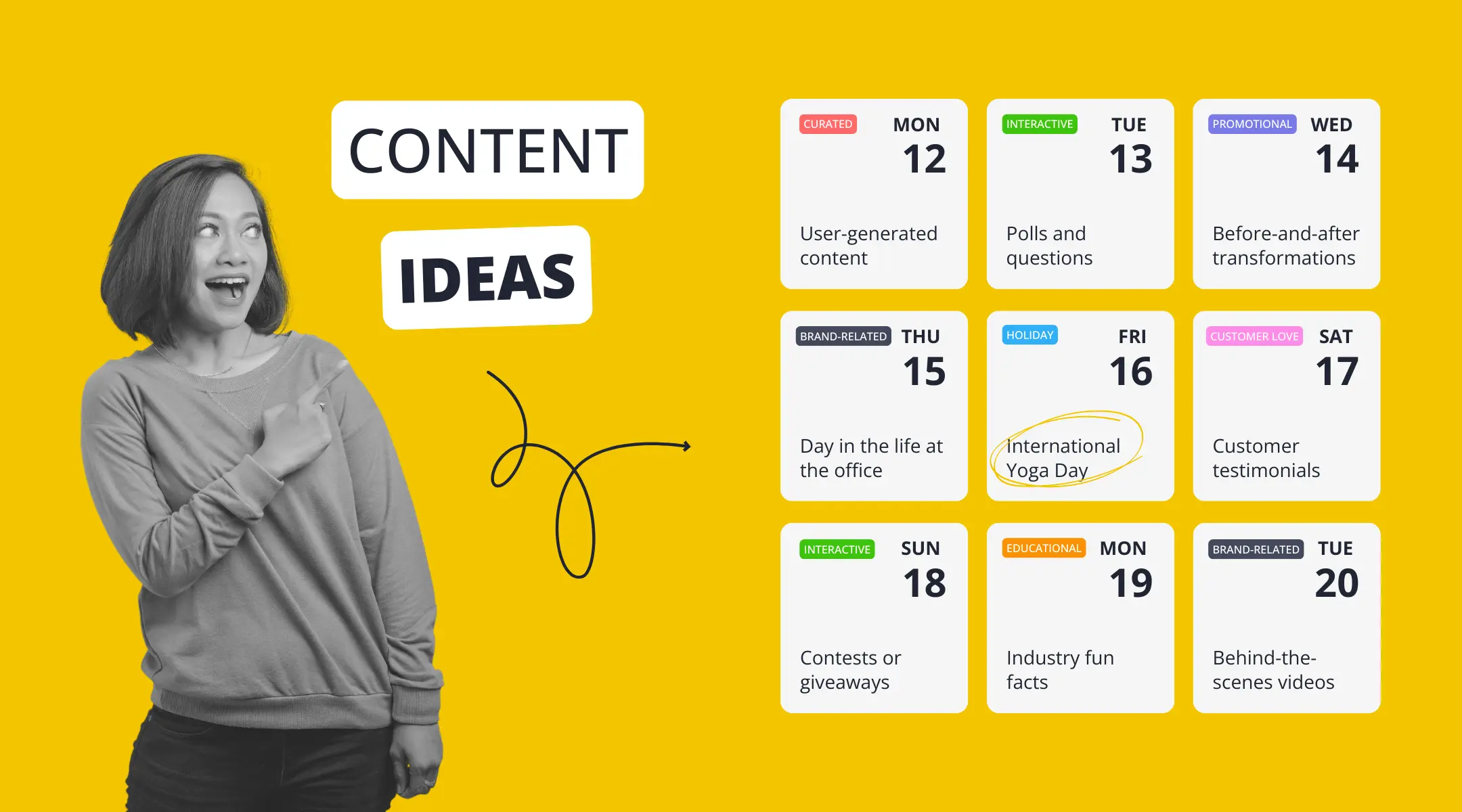
Guest Author
Recognizing the competitive landscape is essential when developing a SaaS marketing strategy. In 2022, in the United States there were 17,000 software-as-a-service (SaaS) companies, all trying to capture the attention of potential customers. 2,000 SaaS companies were doing the same in the United Kingdom. In total, these businesses attracted more than 60 billion customers.
Are you part of a SaaS company seeking to grow your market share or contemplating launching a new SaaS product? Effective digital marketing strategies can be pivotal. Our article aims to outline how you can use digital marketing to elevate your SaaS business.
It’s time to learn more about SaaS marketing strategies!
Get the guide for creating a social media marketing plan for your business.
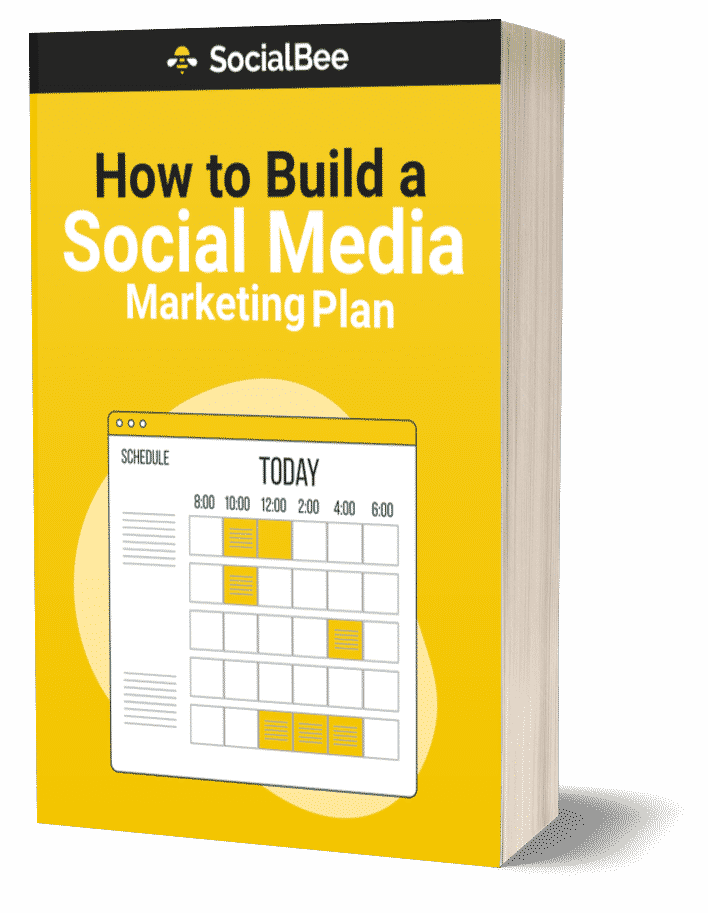
Short Summary:
- For SaaS companies to grow, effective digital marketing strategies are crucial, as thousands of companies compete for customer attention.
- Because both were created in the digital age and challenge established business structures, there is a strong synergy between digital marketing and SaaS products.
- Customer acquisition, retention strategies, relationship-building, and an understanding of the sales funnel are essential components of digital marketing for SaaS enterprises.
- The components of a good SaaS marketing plan inclue understanding the target market, choosing the appropriate digital marketing channels, concentrating on the value proposition, utilizing content marketing, optimizing for conversions, embracing retention marketing, and analyzing and iterating.
- Some of the top digital marketing methods for SaaS enterprises are offering on-page free trial memberships, boosting search engine visibility and organic traffic, utilizing content marketing and social media, and engaging in cross-promotions for mutual gain.
Table of Contents
Why Digital SaaS Marketing Stratkeegies Matter
In the ever-evolving digital world, the SaaS landscape has grown exponentially since Salesforce introduced its trailblazing subscription-based customer relationship management (CRM) tool in 1999.
In a market where everyone claims to have the “best” option, the difficulty is in grabbing and holding potential users’ attention. And as companies struggle to differentiate themselves, one aspect has become more and more obvious: without planned and focused marketing, even the most ground-breaking SaaS solutions risk becoming irrelevant.
Digital Marketing and SaaS Products: A Match Made in Heaven
In the modern digital age, the synergies between digital marketing and SaaS products are undeniable.
Here are some of the clearest similarities between digital marketing and SaaS businesses:
- Origin of disruption: Both digital marketing and SaaS stand as disruptors. Digital marketing has reinvented brand promotion, while SaaS has reshaped software acquisition.
- Digital natives by birth: Neither had to adapt to the digital space – they were born into and flourished within it. This inherent digital nature makes their pairing even more potent.
- Intangibility is their strength: Physical collateral isn’t needed for either. Their value and delivery are completely digital.
- Varied objectives, unified vision: While digital marketing spans all online channels to drive sales, B2B SaaS marketing focuses on nurturing long-term relationships for sustained subscription renewals.
In essence, the union of digital marketing and SaaS is not just strategic—it’s symbiotic. Leveraging this partnership effectively can set SaaS companies on a trajectory of unparalleled growth and recognition.
Key Elements of Digital Marketing for SaaS Businesses
Mastering these fundamental pillars is instrumental in navigating the dynamic SaaS landscape:
- Customer Acquisition: Winning new customers is the starting point for every SaaS venture. Effective digital marketing tactics play a pivotal role here. Dive into content marketing, leverage paid advertising, focus on SEO, and explore affiliate partnerships to scale customer acquisition.
- Retention Focus: Unlike conventional digital marketing, SaaS marketing heavily prioritizes existing customers, aiming for prolonged engagements and renewals. Engage users through email marketing, offer webinars and training, introduce loyalty programs, and integrate regular feedback mechanisms to keep customers onboard.
- Relationship Building: The SaaS industry thrives on trust and reliability, underscoring the need for relationship-centric marketing strategies. Foster community interactions, personalize outreach efforts, ensure prompt customer support, and participate in industry events to strengthen ties with your user base.
- Understanding the Sales Funnel: Recognizing where potential clients are in the sales funnel and catering to their specific needs at each stage is crucial. Implement lead scoring techniques, launch retargeting campaigns, use drip email sequences, and design customized landing pages to guide prospects smoothly through their purchasing journey.
Ultimately, while there’s an inherent difference in approach between traditional digital marketing and SaaS marketing, the contrasts are evident. Traditional digital marketing often emphasizes broad reach, immediate sales, and one-time conversions.
In contrast, SaaS marketing focuses on long-term customer relationships, recurring revenue models, and sustained user engagement. Yet, despite these distinctions, both remain intertwined and indispensable in the SaaS ecosystem.
For SaaS businesses to flourish, the first step lies in garnering a clientele base via robust digital marketing endeavors. Following this, the emphasis shifts to retention and relationship nurturing, ensuring sustained growth and revenue.
Top Four Digital Marketing Strategies for SaaS Companies
Digital marketing offers SaaS companies the potential to not only attract but also engage and keep their target audience thanks to its large selection of tools and methods. The top four digital marketing strategies for SaaS organizations that may keep them abreast of consumer trends and business advancements are listed below.
These tactics could be the spark for your subsequent growth spurt whether you’re a startup or an established SaaS player:
- Content marketing and social media
- On-page free trial subscriptions
- Search engine visibility and organic traffic
- Cross-promotions
1. Content Marketing and Social Media
SaaS content marketing is another powerful digital marketing channel SaaS companies can leverage to drive traffic to their websites and ultimately support business growth.
Sharing relevant content that recognizes the pain points of potential customers and offers solutions has several advantages. One piece of content can be published on several platforms, including your company’s website and your social media channels to generate leads and encourage trials or paid-for subscriptions.
Depending on the length and format of your content, it’s worth customizing the piece for different channels to ensure a great fit between content and audience. To post on your social media channels more effectively, consider using a social media management platform, such as SocialBee.
Connect all your social media accounts and craft your posts with SocialBee.
Start your 14-day free SocialBee trial now!
Discover the features SocialBee brings to the table:
- Supported Platforms: Facebook, Instagram, Threads, X (Twitter), LinkedIn, Pinterest, Bluesky, Google Business Profile, TikTok, and YouTube.
- In-app Design Tools: Craft striking posts using our integrations with Canva, Unsplash, and GIPHY.
- AI-powered Creativity: Let our AI Post Generator produce captivating captions and visuals.
- Organized Content Strategy: Organize your posts in different and varied content clusters and mix up your posting strategy.
- RSS Feed Connection: Seamlessly pull content from any blog.
- Tailored Posts: Personalize content for each social platform.
- Smart Hashtag Creation: Generate hashtags relevant to your visuals or descriptions automatically.
- Content Lifecycle Management: Repost your evergreen content or set expirations on timely content.
- Streamlined Posting Calendar: Set up and visualize your posting timetable across profiles.
- Content Preview: View the next 100 scheduled social media posts at a glance.
- Team-Centric Tools: Manage multiple workspaces and foster team collaboration.
- Link Performance Insights: Keep your links short and trackable with our 5+ URL shorteners.
- Performance Analytics: Monitor your social media performance from one insightful analytics dashboard.
- Active Engagement: Respond to comments, mentions, and DMs from your audience directly from SocialBee.

Manage Your SaaS Social Media Accounts with SocialBee!
2. On-Page Free Trial Subscriptions
Think of traditional sales and how consumers choose products – many like to see and try the physical product before committing to making a purchase. SaaS businesses can make their subscriptions tangible like that by offering trial subscriptions. For example, if you want to subscribe to SocialBee, you’ll first benefit from a 14-day free trial period. How cool is that?
Trial subscriptions are among the strongest digital marketing and lead-generation tools for SaaS products. They must be simple to sign up for and not request a lot of personal data from customers in order to be effective.
There is simply no need for a credit card or other financial information at this time. Remember that the idea is to give users a chance to test out a tool before requesting a commitment.
3. Search Engine Visibility and Organic Traffic
How do potential buyers find your brand online? Without search engine visibility, even the most enticing product trial will not deliver the leads and conversions your brand is looking for.
There are two elements to creating or enhancing your SaaS business’ visibility in the search results of Google, Bing, and others. Search engine marketing (SEM) refers to paid-for digital marketing activity, while search engine optimization (SEO) generates organic traffic.
Search engine rankings can be one of the most effective digital marketing channels for your SaaS business. However, even with the best SaaS SEO strategy and page optimization, it takes time for rankings to improve.
If your brand needs to generate leads in the short term, consider paid-for search engine marketing opportunities. Those can drive traffic to your product immediately, while your team continues working in the background to optimize your key pages.
On-Page vs. Off-Page Digital Marketing
For a successful SaaS marketing strategy, let’s start with understanding the core difference between off-page and on-page marketing!
On-Page Marketing
This strategy is centered around optimizing content within your website to engage visitors. It includes tactics such as improving the user experience, enhancing site speed, optimizing for search engines, and offering high-quality content.
On-page marketing often resonates well with existing customers, prompting them to renew subscriptions, consider upgrades, or even make referrals. It sets the tone for the customer journey by showcasing the brand’s value right on its home turf.
Off-Page Marketing
This approach is about amplifying your brand’s presence outside its website. Tactics might involve building backlinks from reputable sources, guest posting on industry-related blogs, or engaging in influencer partnerships.
Especially during a SaaS company’s nascent stages, off-page marketing becomes indispensable. It brings in fresh leads and aids in positioning the brand across different digital landscapes. However, as the business matures, the balance might tilt slightly more towards on-page efforts, given the larger base of existing customers.
4. Cross-Promotions
Engaging in cross-promotions with a complementary brand is a strategic way to amplify your SaaS business’s reach. While the synergy could arise from the nature of the products themselves, it might also stem from mutual values or visions—such as sustainability or future industry trends.
By collaborating in marketing efforts, both companies can tap into each other’s customer bases, effectively doubling their audience exposure.

For instance, the collaboration between Uber and Spotify, where users could sync their Spotify accounts and stream their chosen tracks through the car’s speakers, was mutually advantageous. This integration led to an uptick in Uber users subscribing to Spotify Premium and concurrently, an increase in Spotify users opting for Uber rides.
This collaborative approach also divides the labor and financial burdens of the campaign, making it a win-win strategy for both brands.
How to Create an Effective SaaS Marketing Strategy
For SaaS businesses aiming to establish a formidable presence in the market, having an innovative product is just the starting point. The true challenge lies in positioning that product to capture the attention and loyalty of the intended users. Crafting a comprehensive SaaS marketing strategy is crucial to this endeavor.
Here’s how to create an effective strategy that appeals to potential SaaS customers:
- Understand your target audience and create buyer personas
- Choose the most effective digital marketing channels
- Focus on value proposition
- Create high-quality content
- Optimize for conversions
- Embrace retention marketing
- Analyze and iterate
1. Understand Your Target Audience and Create Buyer Personas
The foundation of a potent SaaS marketing strategy is recognizing and understanding the prospective users of your product. In times past, marketing strategies relied heavily on broad demographic data to segment and target consumer groups.
For instance, businesses would target males or females within a specific age bracket who boasted a certain disposable income. This approach, while functional, often lacked nuance and precision.
That’s no longer the case in the time of digital marketing.
With the advent of advanced digital marketing channels, the scope for precision has expanded exponentially. Instead of the broad strokes of traditional marketing, brands now have the tools and resources to craft highly detailed buyer personas, offering a more granular view of their target audience.
What Exactly Is a Buyer Persona?
Essentially, a buyer persona is a semi-fictional representation of a segment of a company’s customer base. These segments, or personas, are crafted based on shared behaviors, motivations, expectations, goals, and yes, even some demographics.
However, unlike traditional demographic-based segmentation, buyer personas delve into the psyche of the customer. They aim to understand not just the ‘who’ but the ‘why’ behind purchasing decisions. In addition to creating positive buyer personas that represent your ideal customers, it can also be insightful to develop a negative persona. This archetype embodies traits and characteristics of individuals who might exhibit reasons or behaviors that are contrary to your target audience. A negative persona can provide valuable insights into potential pitfalls or challenges in your marketing strategies, helping you refine your approach and better understand the nuances of your market.
One valuable resource that offers in-depth insights on crafting these personas is SocialBee’s buyer persona template. It simplifies the process of creating detailed personas, ensuring that brands capture the essence of their potential customers.
Grab the free template, fill it out, and swiftly craft your buyer persona.
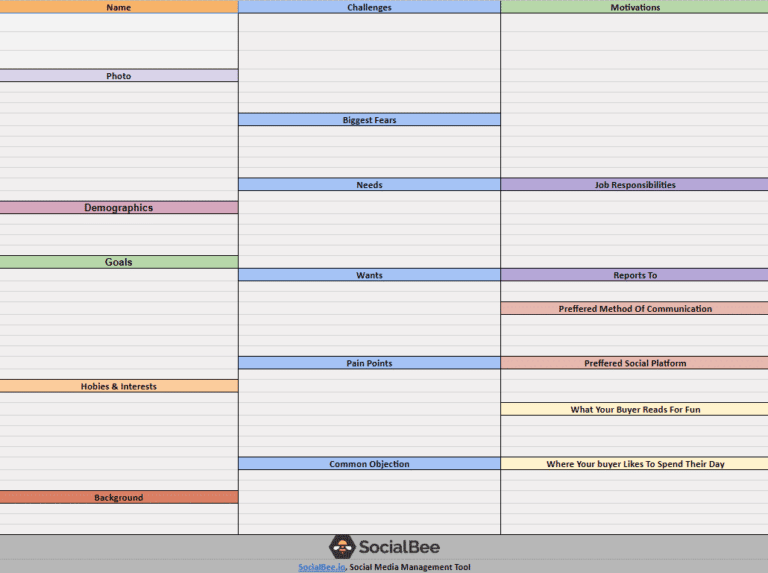
Incorporating platforms like SocialBee can also be transformative. SocialBee allows you to access detailed demographic data of your users. By integrating these insights with the persona creation process, you can develop even more accurate and tailored marketing strategies.
Get to know your target audience by leveraging SocialBee’s demographic data!
Start your 14-day free trial now!
The importance of buyer personas in SaaS marketing cannot be understated. They provide a window into how customers might feel and behave during the subscription purchasing process. These personas enable marketers to anticipate needs, customize messaging, and essentially target consumers with greater effectiveness and empathy.
Transitioning from broad demographic categorizations to detailed buyer personas represents a pivotal shift to a more empathetic and customer-centric marketing approach. In the SaaS domain, where the goal is not just to attract but retain customers, these personas can be the linchpin for long-lasting relationships and business growth.
2. Choose the Most Effective Digital Marketing Channels
For SaaS marketers, creating an effective marketing strategy means aligning their tactics with the unique characteristics and preferences of their target market.
After shaping well-defined buyer personas, the next pivotal step is to tailor your SaaS marketing strategies to platforms and channels where these personas are most active.
A prevalent pitfall among SaaS marketers, especially those new to the game, is attempting to make a mark on every conceivable platform when following SaaS marketing strategies. However, without a targeted approach, even the most passionate marketing efforts can get drowned out by larger, omnipresent brands. Instead of casting a wide, unspecific net, SaaS businesses should strive for strategic focus and depth.
Some of these vital SaaS marketing spaces include:
- Your own website: Your website is the first touchpoint for prospective clients, so it’s safe to say that optimizing it for conversions, user experience, and valuable content is an essential part of your marketing strategy.
- LinkedIn: A hub for B2B SaaS, where professionals and industry leaders converge.
- Twitter: A real-time platform, ideal for engaging with tech aficionados, startups, and industry thought leaders.
- Facebook: Beyond its B2C nature, it houses numerous industry-centric groups and communities.
- Instagram: Suitable for SaaS ventures that can leverage visual content or those eyeing a younger audience segment.
- Webinars & virtual conferences: A stage for detailed product showcases, interactive Q&A sessions, and expert-led discussions.
- Industry-specific blogs & forums: These digital havens host niche discourse and often value expert insights.
- YouTube: A platform for video tutorials, product demos, and client testimonials.
3. Focus on Value Proposition
With a clear understanding in hand, list every feature your product offers. Don’t just stop at the functionality; delve deeper to highlight the benefits each feature brings.
Here’s how to craft your value proposition in five steps:
- Highlight your product’s features and benefits: Start by listing all the features your product brings to the table. Go beyond the basics and delve into how each feature directly benefits users. For instance, instead of just mentioning speed, explain how this speed translates into saving time and boosting productivity.
- Study your competitors: Step back and take a look at how your competitors are presenting their products. Identify where your product stands out in comparison. Maybe your tool is more user-friendly or offers a more comprehensive package. These unique qualities will set the stage for your value proposition.
- Craft an initial value proposition: Based on the insights you’ve gathered, create a succinct and clear value proposition that captures the core advantages of your product. Avoid using industry jargon so that it’s easy to understand for both industry experts and newcomers.
- Refine your value proposition collectively: Share your initial value proposition with stakeholders, current users, and individuals who aren’t familiar with your field. Collect a range of perspectives to fine-tune your messaging and make it more compelling.
- Integrate your value proposition into your marketing strategy: Once you’ve polished your value proposition, make it the heart of your marketing strategy. Display it prominently on your website and weave it into all your marketing channels and campaigns.
| Example: Imagine promoting a project management software. | |
Original value proposition: Our software is faster and more efficient. | Refined value proposition: Streamline your projects effortlessly with our user-friendly software. Save time, boost productivity, and achieve more. |
4. Create High-Quality Content
Content stands tall as the most formidable tool for SaaS brands. An effective SaaS content marketing strategy doesn’t merely promote a product; it builds relationships, educates the audience, and positions your brand as a beacon of value in a crowded market.
Understanding the role of content begins by acknowledging its power to transform passive readers into qualified leads. It’s not about overtly pushing your product, but crafting stories and information that resonate with prospective customers’ pain points. When your content offers solutions and showcases your SaaS tool as an answer, you’re speaking directly to the needs and interests of your audience.
An integral part of this content creation is rooted in SEO. By researching and integrating relevant keywords, your content aligns with the very queries and concerns of your prospective customers. It’s a twofold benefit: your content becomes discoverable on search engines and also directly addresses what your audience is actively seeking.
However, creating SEO-optimized, compelling content can be a demanding task. This is where ConciergeBee’s Content Machine services come into play. We understand the nuances of SaaS marketing and ensure your content is not only tailored to your audience but also primed for search engine success. With their vast expertise, you can save time, ensure quality, and elevate your brand’s digital presence.
But the digital realm isn’t monolithic. While a blog post can delve deep into a topic, the nuances of social media platforms mean that content must be adapted and diversified. A detailed guide might be perfect for your website, but on platforms like Twitter or Instagram, snippets, highlights, and visual content take center stage.
Enter email marketing, often an underrated champion in the content arena. By delivering valuable insights directly to the inboxes of potential customers, you create a personal touchpoint. Newsletters, product updates, or exclusive tips can nurture leads and maintain engagement with existing customers.
5. Optimize for Conversions
Driving traffic to your website or landing page is only a fraction of the challenge; the real task is converting this traffic into loyal customers.
Here’s how to optimize your SaaS marketing strategy for conversions:
- Design: Ensure that your website’s design is intuitive and user-friendly. A complex design can deter potential customers. Use clear fonts, simple layouts, and avoid clutter.
- Compelling CTAs: Your call-to-action should be clear, compelling, and strategically placed. Whether it’s “Start a Free Trial” or “Book a Demo”, make sure it stands out and guides the user effortlessly.
- Value-oriented landing pages: Create landing pages that center on the benefits of your SaaS product. Utilize A/B testing to determine which version resonates most with your audience.
- Mobile optimization: With a significant chunk of users accessing sites via mobile, ensuring your website is mobile-friendly is non-negotiable.
- Speed: A slow-loading site can deter potential customers. Ensure your site’s loading times are optimized.
- Chatbots and Live Support: Offering real-time assistance can resolve user queries instantly, enhancing the chances of conversion.
- Clarity in SaaS pricing: If your SaaS has varied pricing tiers, make sure they’re transparent and easy to comprehend.
- Tailored user experience: Personalizing content based on user behavior can make the user feel catered to, increasing the likelihood of conversion.
Spotlight on Trello: A Case in Conversion Optimization
Trello, a popular visual collaboration tool, exemplifies an effective SaaS conversion strategy. Their user interface stands out for its simplicity, utilizing an intuitive card-based system that appeals to newcomers. Paired with a clear CTA and benefit-centric landing pages, they address users’ needs right from the start.
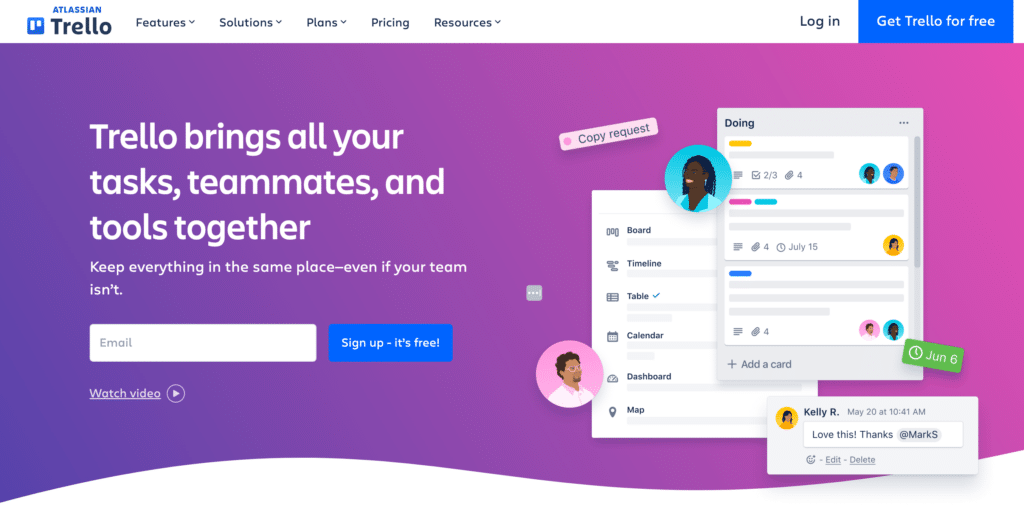
Furthermore, Trello’s transparent pricing and tailored user experiences, like custom power-ups and integrations, make the platform adaptable for diverse workflows. This attention to detail at each touchpoint not only enhances user satisfaction but also drives conversions.
For SaaS businesses aiming to refine their conversion approach, taking cues from Trello’s playbook can be invaluable. Harnessing these elements in tandem can significantly enhance the conversion rate, ensuring that the website visitors you’ve worked hard to procure don’t merely browse, but take the next step in their customer journey.
6. Embrace Retention Marketing
Retention marketing, while sometimes overlooked in the shadow of acquisition efforts, is a powerful driving force for sustainable growth in the SaaS realm.
Focusing on current customers, rather than constantly chasing new ones, can significantly elevate your ROI, given that it often costs more to attract a new customer than to retain an existing one.
Here are our tips for retaining paying customers:
- Prioritize onboarding: A seamless onboarding experience sets the tone for the entire customer relationship. Make sure users are given a proper introduction to your platform, understand its full capabilities, and can easily navigate its features.
- Invest in customer success: Beyond solving problems, provide resources and training that empower your users. This could involve webinars, tutorials, or dedicated customer success representatives.
- Implement a referral program: Incentivize your loyal and satisfied customers to become brand ambassadors. Offer them perks or discounts for every successful referral, encouraging them to spread the word.
- Monitor customer churn: Actively keep track of the customers you’re losing and why. Send out exit surveys or conduct feedback sessions to gain insights into areas of improvement.
- Engage regularly: Don’t wait for your customers to reach out. Regular check-ins, updates, and personalized content can make them feel valued and heard.
- Optimize feedback loops: Encourage feedback, both positive and negative. Use it constructively to iterate on your product and services. Recognize that every piece of feedback is an opportunity for growth.
- Offer loyalty perks: Whether it’s through exclusive features, discounts, sales promotions, or early access to updates, reward your long-term customers for their loyalty.
- Stay ahead of issues: Proactive customer service can identify potential problems before they escalate. Tools that monitor user activity can alert you when users encounter repeated issues or stop using certain features, allowing you to intervene timely.
If you include these actions in your marketing plan, your SaaS business not only strengthens its relationship with its present clients but also increases the likelihood that they will stick around and become long-term, paying customers. Keep in mind that in the SaaS industry, customer retention is more than simply a strategy—it’s a growth engine.
7. Analyze and Iterate
What worked yesterday might not necessarily be the best strategy today. As market dynamics, customer preferences, and technology landscapes shift, businesses must be agile, adapting their strategies to stay ahead.
This is where the principle of ‘Analyze and Iterate’ shines, ensuring that companies don’t just react to changes, but proactively harness them for growth.
Here’s what you can do in order to always stay at the top of your SaaS marketing strategy:
- Deep dive into data: At the heart of any iterative strategy is data. Comprehensive analysis provides insights into what’s working and what’s not, helping businesses refine their strategies. Using analytics tools, you can monitor website traffic, track conversion rates, measure customer engagement, and much more.
- Collect feedback: Actively seek feedback from your users. They are the ones interacting with your product daily, and their experiences offer invaluable insights. Negative feedback, while sometimes hard to hear, can be especially useful in highlighting areas that need immediate attention. Using customer experience management software can simplify this process, collecting all feedback that has been shared with you and helping to analyze the findings.
- Regularly review goals and metrics: Set specific, measurable, attainable, relevant, and time-bound (SMART) goals for your SaaS business. Regularly review these objectives against the metrics you’ve established. If goals aren’t being met, it’s time to pivot or adjust.
- Stay updated with industry trends: The SaaS sector is dynamic. New technologies, strategies, and customer preferences emerge frequently. By keeping a pulse on the industry, you can anticipate changes and adjust your strategies accordingly.
- Be open to change: After all the analysis, be ready to make changes. Whether it’s tweaking a feature, overhauling a marketing campaign, or even pivoting the product, flexibility can be a competitive advantage.
Frequently Asked Questions (FAQ)
SaaS marketing refers to the strategies and tactics employed to promote and sell SaaS products. This type of marketing entails raising awareness of the product, drawing in potential clients, turning leads into paying subscribers, and keeping those clients over the long haul.
It emphasizes utilizing digital marketing channels, including social media, content marketing, search engine optimization, email marketing, and others, to successfully reach and engage target audiences.
The choice of the best marketing strategy for a SaaS company depends on specific goals, target audience, and resources available.
For best results, use a combination of these SaaS marketing strategies:
- Content Marketing: This strategy provides valuable information to your audience, showcases your expertise, and builds trust. It can include blog posts, videos, webinars, and eBooks that address your customers’ pain points and offer solutions.
- Free Trials and Demos: Offering free trials allows potential customers to experience your SaaS product firsthand, increasing the likelihood of conversion. Demos can also help showcase your product’s value in a guided manner.
- Conversion Optimization: Make sure your website and landing pages are optimized for conversions. Clear CTAs, persuasive copy, and user-friendly design enhance the chances of turning visitors into leads.
By combining these strategies, you can attract and engage potential customers, demonstrate your product’s value, and guide them toward becoming paying subscribers.
B2B SaaS marketing involves a targeted approach that speaks to the specific needs and challenges of other businesses.
Here’s a step-by-step guide on how to effectively market your B2B SaaS:
- Decide who your target market is and what their problems are.
- Stress the importance and difficulties your solution addresses.
- Create informative content like blog posts and webinars.
- Optimize your website for search engines (SEO).
- Offer free trials or demos to showcase your product.
- Showcase customer success stories and testimonials.
- Engage on social media, especially LinkedIn.
- Build partnerships and integrations.
- Host webinars and attend industry events.
- Provide exceptional customer support and onboarding.
- Continuously analyze and refine your strategy based on results.
Ready to Follow the SaaS Trajectory?
Leading brands globally are soaring high, backed by the unparalleled advantages of digital marketing. Its unparalleled cost-efficiency, laser-focused targeting, and tangible outcomes are shaping the success stories of today.
With the meteoric rise of SaaS enterprises, both in the U.S. and internationally, the synergy with dynamic digital channels has never been more vital.
As we stand on the cusp of a digital revolution, isn’t it time to revitalize your SaaS marketing blueprint? Dive in deeper, streamline, and make your mark.
And for a seamless journey ahead, consider using SocialBee to schedule your social media posts, ensuring a consistent and engaging digital presence.
Here’s to a future where your brand doesn’t just participate but leads the conversation. Start your 14-day free SocialBee trial now!

Manage Your SaaS Social Media Accounts with SocialBee!
About the author: Joseph “OG” Meyers has been helping founders find their #1 growth blocks for almost 5 years now. When we don’t have answers, in Joe, we trust. He is also why Quarantine Karaoke exists, and the world is better for it. Wish you could get Joseph’s thoughts on your business? Apply for a free growth session with Joe here.

